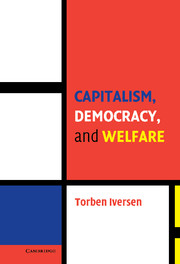Book contents
- Frontmatter
- Contents
- Tables
- Figures
- Acknowledgments
- Capitalism, Democracy, and Welfare
- Part I Welfare Production Regimes
- Part II Political Foundations of Social Policy
- Part III Forces of Change
- 5 COPING WITH RISK : THE EXPANSION OF SOCIAL PROTECTION
- 6 NEW TRADEOFFS, NEW POLICIES: CHALLENGES OF THE SERVICE ECONOMY
- Bibliography
- Index
- Titles in the series
6 - NEW TRADEOFFS, NEW POLICIES: CHALLENGES OF THE SERVICE ECONOMY
Published online by Cambridge University Press: 05 September 2012
- Frontmatter
- Contents
- Tables
- Figures
- Acknowledgments
- Capitalism, Democracy, and Welfare
- Part I Welfare Production Regimes
- Part II Political Foundations of Social Policy
- Part III Forces of Change
- 5 COPING WITH RISK : THE EXPANSION OF SOCIAL PROTECTION
- 6 NEW TRADEOFFS, NEW POLICIES: CHALLENGES OF THE SERVICE ECONOMY
- Bibliography
- Index
- Titles in the series
Summary
This chapter applies the welfare production regime argument to the case of service employment and tests its economic and political implications. Because job growth in high-skilled, better-paid services is limited by the size of the domestic market, whereas growth in low-skilled, low-paid service jobs is hampered by wage compression and high social costs, the transition toward a more sheltered postindustrial economy has produced a difficult tradeoff between equality and employment, mediated only by the willingness of the government to increase public employment or subsidize private employment at a cost to tax payers.
As Anne Wren and I have argued (Iversen and Wren 1998), governments initially responded to this “trilemma” in a manner that clearly reflected partisan preferences and broader institutional conditions. Thus, right governments in liberal market economies sought to further deregulate labor markets, whereas governments in coordinated market economies embarked on policies to either ration work (primarily in countries with independent central banks and strong Christian democratic parties) or to increase spending on public employment (primarily in countries with highly centralized wage bargaining and strong social democratic parties). The division between varieties of capitalism described in Part I has thus been overlaid by new divisions that are the result of different political responses to deindustrialization.
- Type
- Chapter
- Information
- Capitalism, Democracy, and Welfare , pp. 217 - 278Publisher: Cambridge University PressPrint publication year: 2005

